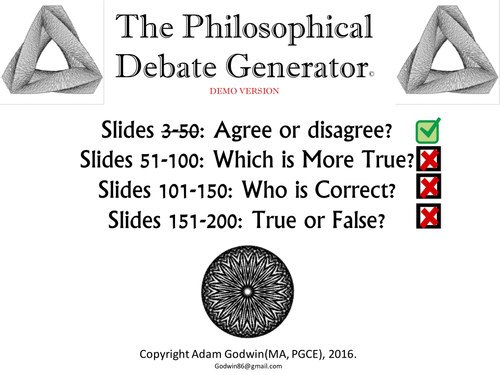

This download is a demo version so that you can try the method and see how effective it is with your classes.
The full version can be found here: https://www.tes.com/teaching-resource/-p4c-the-philosophical-debate-generator-200-slide-ppt-with-randomiser-philosophy-for-kids-11382893
______________________________
About the full version:
This is a 200 slide PPT, containing 198 philosophical debates, discussions, and dilemmas.
It also contains a ‘randomiser’ slide: when clicked a random moral problem is presented to the group.
Uses:
-P4C (Philosophy for kids)
-Form time activities
-R.S./Philosophy/Citizenship cover lessons
-Debating societies
-Making best use of spare time at the end of lessons
Discussions follow one of four formats, each asking students to move from one side of the room or the other to make their position clear: teachers should then use questioning to foster a debate between students, encouraging them to present reasons for their choice and defend their position.
The formats are:
-Is the statement TRUE of FALSE?
-Whose side do you take?
-Agree or Disagree?
-Which statement is more true?
This resource is great value at £4.99 and cannot be found elsewhere:
-It clearly contributes to your school’s SMSC provision
-Furthers students’ critical thinking skills
-It allows for countless hours of discussion and debate to be structured in a focussed and engaging manner.
-It would take days to reproduce yourself.
-It can save vast amounts of staff time in preparing cover lessons
-It is the perfect way to make the most of any time a teacher might have left at the end of a lesson.
-It deals with cross curricular issues
Please note: this resource deals with controversial issues, debates and questions that may be deemed unsuitable for younger children. It is designed for secondary school students, but can be easily adapted to younger years with appropriate amendments by their teacher.
Something went wrong, please try again later.
Brilliant resource. Thank you!
A great starter activity to encourage children to think about a variety of statements. Students will love the interactivity of moving to the left or the right of the room to indicate whether they agree or disagree and it means everyone has to engage. A nice idea and a great resource.
Report this resourceto let us know if it violates our terms and conditions.
Our customer service team will review your report and will be in touch.